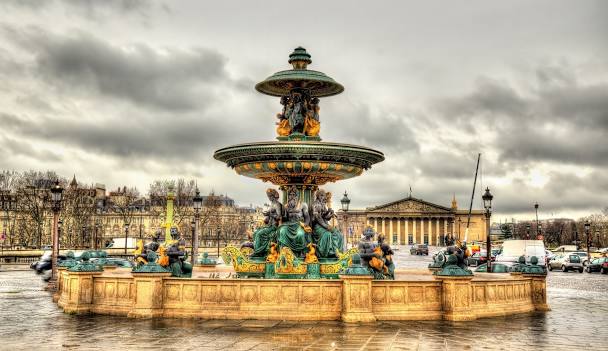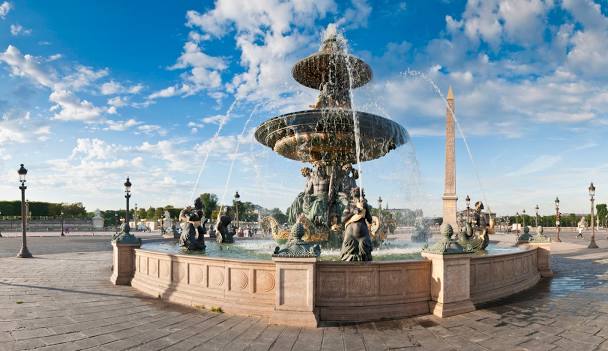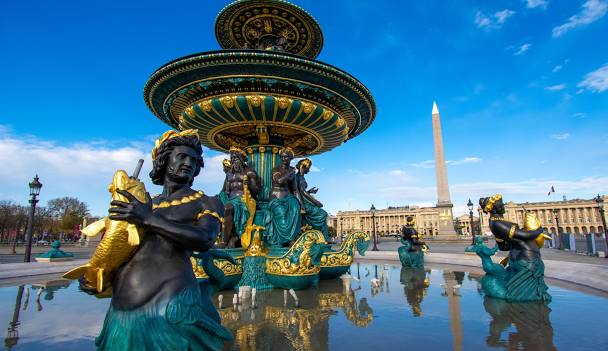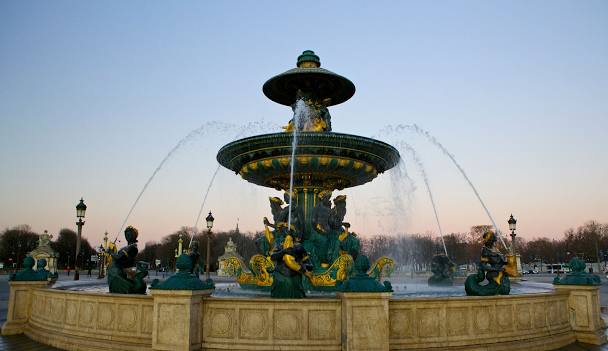The Fontaines de la Concorde, two monumental fountains located in the iconic Place de la Concorde, are among Paris’s most captivating landmarks. Designed by the renowned architect Jacques Ignace Hittorff, they were completed in 1840 during the reign of King Louis-Philippe, symbolizing France’s maritime and riverine heritage. Follow archeology.dulichvn.net to learn more about mysterious artifacts.

A Historical Overview
The Vision of Jacques Ignace Hittorff
Jacques Ignace Hittorff, the visionary architect behind the design of Place de la Concorde, conceived the Fontaines de la Concorde as a perfect fusion of artistry and functionality. Influenced by the grandeur of Roman fountains, Hittorff’s design skillfully incorporated neoclassical elements with Parisian sophistication. His goal was to create not only an aesthetic marvel but also a functional structure that would enhance the public space, offering both beauty and utility. By blending the traditional and the contemporary, he succeeded in elevating the fountains to iconic status, symbolizing the cultural and artistic zenith of 19th-century France.
Construction Under King Louis-Philippe
The construction of the Fontaines de la Concorde was commissioned during the reign of King Louis-Philippe as part of an ambitious urban beautification initiative for Paris. The fountains, completed in 1840, were a significant contribution to this larger project, which aimed to modernize the city and assert its position as a cultural center of Europe.
During the July Monarchy, the fountains became emblematic of the nation’s growing industrial prowess and cultural sophistication. Their design and placement were intended to reflect the strength and progress of France during a time of transformation and prosperity, and they have remained a testament to the architectural and industrial achievements of the 19th century.
The Role of Place de la Concorde
Place de la Concorde, one of Paris’s most storied and central squares, has long served as a symbol of the city’s dynamic history. The Fontaines de la Concorde anchor this historically rich location, which has borne witness to a wide array of significant events, from royal celebrations and public festivities to revolutionary upheavals and political demonstrations.
The fountains not only enhance the square’s visual grandeur but also serve as enduring symbols of France’s shifting political and cultural landscape. As both artistic and historical landmarks, they reflect the evolution of Paris from a monarchy to a republic, encapsulating the complex and ever-changing identity of the French capital.

The Design and Symbolism
The South Fountain: Celebrating Maritime Commerce
The South Fountain at Place de la Concorde is a striking tribute to France’s maritime commerce and industrial strength. Featuring sculptural elements that represent the oceans and seas, it emphasizes the crucial role of naval power and international trade in establishing France’s dominance on the global stage. The figures that adorn the fountain evoke the power of the sea, with allegorical depictions of maritime symbols and deities. These elements not only highlight France’s naval history but also celebrate the nation’s deep connection to global trade and exploration, which were instrumental in shaping its cultural and economic legacy.
The North Fountain: Symbol of River Navigation
In contrast, the North Fountain celebrates the importance of France’s inland waterways, particularly its rivers, in fostering trade and commerce. Adorned with symbolic motifs of rivers, agriculture, and industry, the fountain reflects the vital role that river navigation played in the country’s economic development. The figures representing rivers and agricultural scenes underscore the importance of these natural resources in sustaining France’s agricultural prosperity and facilitating the movement of goods throughout the nation. Through this tribute, the fountain highlights the harmonious relationship between France’s natural landscape and its economic life.
Artistic Details and Craftsmanship
Both fountains are masterpieces of 19th-century French craftsmanship, featuring exquisite bronze sculptures of tritons, naiads, and allegorical figures. Each sculpture is meticulously detailed, showcasing the fine artistry and technical prowess of the period. The dynamic, lifelike depictions of sea creatures, river deities, and symbolic figures embody the era’s fascination with mythological themes and natural beauty. The level of detail in these sculptures demonstrates the exceptional skill of the artists and the high standards of French design during the time of their creation, contributing to the fountains’ status as timeless artistic landmarks.

The Legacy of the Fontaines
A Cultural Landmark of Paris
The Fontaines de la Concorde stand as iconic symbols of Paris’s cultural heritage, drawing millions of visitors to Place de la Concorde each year. Renowned for their timeless beauty and rich historical significance, these fountains have become integral to the city’s charm, offering a glimpse into Paris’s grandeur. As some of the most recognized landmarks in France, they serve as a constant reminder of the country’s artistic and architectural achievements, encapsulating the essence of Parisian elegance and sophistication.
An Endless Source of Inspiration
Throughout the years, the Fontaines de la Concorde have captivated the imagination of artists, architects, and designers alike. Their seamless fusion of functional design and aesthetic appeal has set a high standard in urban planning and artistic expression. The fountains have influenced a wide range of artistic movements, from neoclassicism to modern design, serving as a benchmark for future generations in both architecture and public space design. Their legacy continues to inspire contemporary creations, cementing their place in the cultural zeitgeist.
A Symbol of Parisian Grandeur
The Fontaines de la Concorde epitomize the architectural grandeur of Paris. As symbols of the city’s ability to blend history, art, and innovation, these monumental fountains reflect the sophistication and artistic spirit that define Paris. The fountains embody the city’s deep respect for its cultural heritage while showcasing its forward-thinking approach to design and urban planning. They are not only a testament to France’s royal past but also to the enduring legacy of Paris as a global center of art, architecture, and culture.

Visiting the Fontaines de la Concorde
How to Get There
The Place de la Concorde is easily accessible by public transportation, particularly through the Paris Métro. Concorde Station is conveniently located directly beneath the square, making it a quick and convenient stop on any Parisian journey. Its central location in the heart of the city makes it an ideal addition to any sightseeing itinerary, whether you’re visiting for a few hours or exploring Paris over several days.
Best Times to Visit
The Fontaines de la Concorde offer breathtaking views throughout the year, but they are especially magical when illuminated at night, casting a soft glow across the square. For those seeking the perfect photo opportunity, early mornings and late afternoons provide the ideal lighting conditions, with fewer crowds and a more tranquil atmosphere. Visiting during these times allows you to fully appreciate the beauty and grandeur of the fountains while avoiding peak tourist traffic.
Nearby Attractions
A visit to the Fontaines de la Concorde can easily be combined with other iconic landmarks nearby. The famed Champs-Élysées, one of the most celebrated avenues in the world, is just a short stroll away. Additionally, the picturesque Tuileries Garden and the world-renowned Louvre Museum are within walking distance, offering visitors a full day of art, culture, and history. These attractions, located close to the Place de la Concorde, ensure that your visit to the fountains will be part of a broader Parisian adventure.
See more: The Last Full Moon of 2024 Behind the Great Pyramid of Giza
Conclusion
The Fontaines de la Concorde stand as a testament to Paris’s enduring legacy of art, culture, and history. Whether you’re a history enthusiast or an admirer of fine architecture, these fountains offer a glimpse into the heart of Parisian splendo


CÁC TIN KHÁC
Mary Walton: The Forgotten Inventor Who Helped Clean Up America’s Cities
Tomb of Queen Nefertari in the Valley of the Queens, Egypt
Discover the Hypostyle Hall of the Temple of Hathor at Dendera
Venus de Losange: Unveiling the Mystery of a 20,000-Year-Old Paleolithic Icon